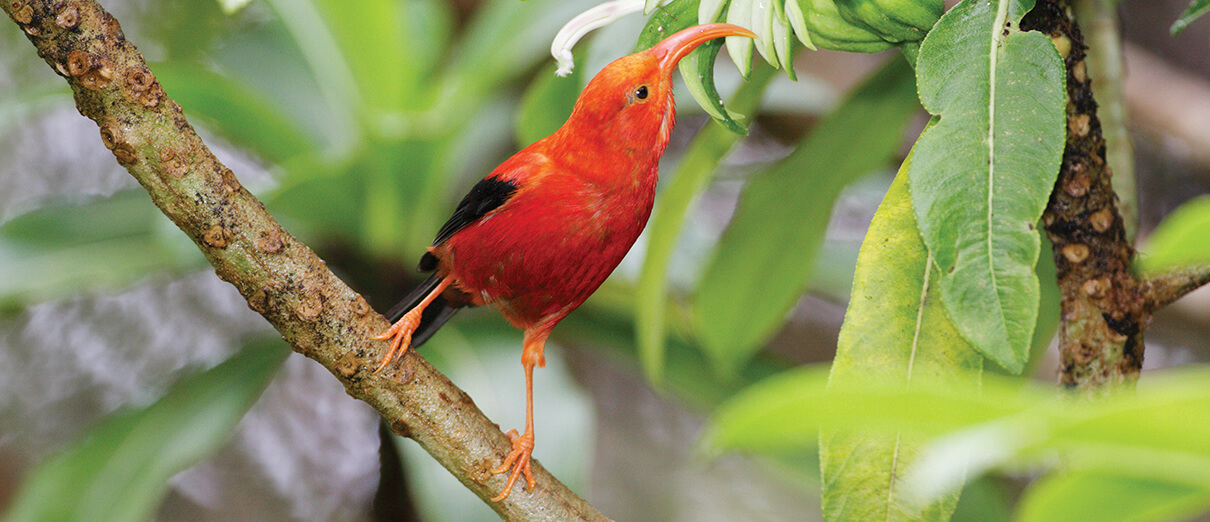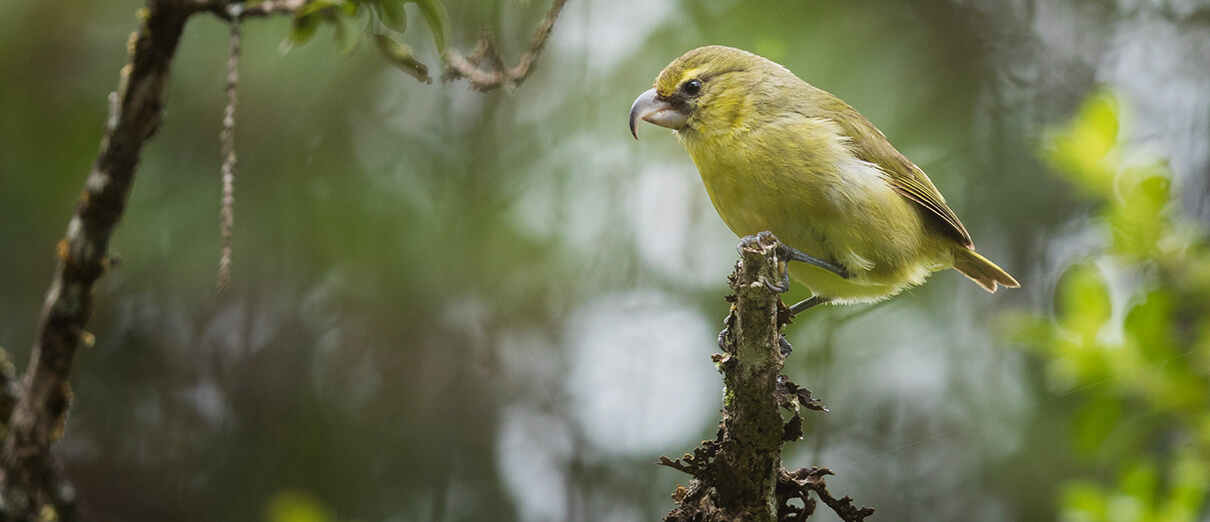Mosquito Birth Control and the Fight to Save Hawaiian Honeycreepers
In this Q&A, ABC's Hawai‘i Program Director Chris Farmer explains why Hawaiian honeycreepers are in such dire straits, and how ABC and partners' urgent initiative aims to save them using Wolbachia — a tested tool in the fight to protect human health.
Why is Hawai‘i sometimes called “the bird extinction capital of the world”?
CF: Because about 15 percent of the world's bird extinctions have occurred here over the last 700 years. We have lost about 67 percent of all Hawaiian birds since humans arrived. Of the remaining native bird species, 78 percent are federally listed — including 11 species that have not been detected in decades and are likely already extinct. The extinction threat in Hawai‘i is orders of magnitude more severe than for imperiled mainland birds. To give you an idea, there are 11 endangered songbird species here that have a combined population of approximately 10,000 birds, far less than the estimated population of the Red-cockaded Woodpecker of the southeastern U.S.

ʻIʻiwi by USFWS, Pacific Region
How many Hawaiian honeycreepers remain and why are they unique?
CF: Hawai‘i is one of the world's most isolated island chains. The distance, spectacular geography, and elevational range here provided an abundance of ecological niches into which newly arrived birds could expand. The endemic Hawaiian honeycreepers are world renowned for their incredible array of bill morphology and plumages. These unique birds arose from a Eurasian rosefinch species that arrived around 5.7 million years ago — before the formation of O‘ahu or any of the younger islands. Detecting avian fossils and pre-fossils in highly active volcanic islands is difficult, but the current estimate is that there were at least 59 different honeycreeper species — of which only 17 survive today.
Why are mosquitoes and the diseases they carry so lethal to Hawaiian honeycreepers?
CF: Because Hawai‘i is so distant from the continents, many creatures and pathogens never arrived here, including mosquitoes and avian malaria. Because the birds had millions of years without exposure to the disease, they lost whatever immunity they had by the time humans brought mosquitoes and malaria to the islands. Some honeycreepers, like ʻIʻiwi, are highly susceptible: One bite from an infected mosquito can cause death. The situation is similar for the Kiwikiu (Maui Parrotbill) that were translocated last year and, sadly, died from avian malaria.
How does climate change contribute to the rapid decline in remaining Hawaiian honeycreepers?
CF: Mosquitoes and the avian malaria parasite need warm temperatures to reproduce, so they were historically limited to the warmer, low elevations of Hawai‘i. The remaining native bird species mostly survive above this “mosquito zone,” in high-elevation forests. However, as temperatures warm, the mosquitoes are able to move up the mountain; the malaria parasite is also able to survive at these elevations, leading to increased disease transmission in previously safe habitats. Increased mosquito density is already being seen on Kaua‘i and Maui, and endemic honeycreepers on both islands are rapidly declining.
What are ABC and its partners doing to save Hawaiian honeycreepers?
CF: The avian disease/mosquito/native bird relationship has been known since the late 1960s, but there were no landscape-scale solutions possible until recently.
Building upon tremendous research and applications aimed at protecting human health, ABC and our local partners have been working on a method to control mosquito populations across thousands of acres to save the birds from extinction. We are mobilizing to use Wolbachia, common bacteria already present in Hawai‘i (and present in over 60 percent of all insects). Male mosquitoes raised in labs from eggs injected with a fertility-altering Wolbachia strain will be released into the wild. Using this strategy, it is possible to prevent the mosquitoes from reproducing: These males do not bite people, but they effectively find and mate with wild, fertile females. Resulting eggs do not hatch. This method is being used in 14 countries, including the United States, to control human diseases.

Kiwikiu (Maui Parrotbill) by Pezzillo Waikamoi
How is this mosquito-control effort different from those using genetically modified mosquitoes?
CF: There is an immense amount of research on mosquitoes and disease for human health, including many different types of modifications of the mosquito's genome. All of these methods modify the mosquitoes' actual DNA, and the changes can be passed on to their offspring, to varying degrees. The Wolbachia method does not alter the mosquito's genome. Using Wolbachia is not self-sustaining, and cannot be passed on to future generations. There will need to be continued releases into the habitat to protect Hawai‘i's birds. Although this will increase the costs, it gives the scientists more control over the program, and if this method knocks back mosquito populations, it will save many species from extinction.
What's next?
CF: ABC and our partners are collecting data on mosquito abundance, distribution, and movement, and will be using this to construct a successful implementation strategy. We have also begun community engagement and outreach, because having local support is necessary for any success. The group is also working to develop and test the efficacy of the Wolbachia mosquitoes to prevent successful mosquito breeding. These results will inform the regulatory process, which includes securing all the required state and federal permits for the project. Learn more.
This project is generously supported by the National Fish and Wildlife Foundation; U.S. Fish and Wildlife Service, Science Applications Program and Recovery Implementation Funds; The Dorrance Family Foundation; Weissman Family Foundation; Atherton Family Foundation; and Kōaniani Fund of the Hawai‘i Community Foundation.
 | Chris Farmer is ABC's Hawai‘i Program Director. |


















































